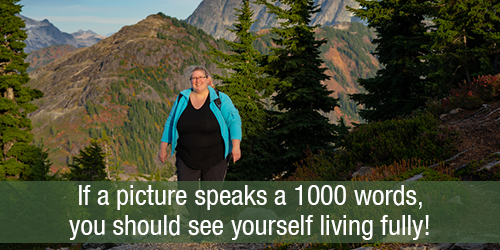As I stood in the check-out line at a retail cosmetics store, I observed a narrow definition of beauty in the giant posters in the window. This was in sharp contrast to the women waiting their turn to purchase products that promised they too could look like that. While there was some diversity in skin tone and ethnicity, nearly all the images featured women in smaller bodies, reflecting the common problem of weight stigma in photography.
Get the picture?
As I looked at the women around me, even catching a glimpse of my own reflection in one of the many mirrors, I noted that no one, not even the sales people behind the counter, looked anything like those huge ads for what our money could (supposedly) buy. Yet I could clearly see uniqueness and beauty in each person.
I’m not surprised to find these images in a place where (mostly) women come to buy beauty—or at least what our culture has been sold as the definition of beauty. It’s everywhere else I turn too: television, movies, magazines, news, websites, social media (especially), and even doctors’ offices.
It’s frustrating to constantly have the “thin-ideal” shoved at us as the epitome of beauty and the picture of health. Everyone has the right to inhabit their body as is—and you can’t tell anything about a person’s health simply by looking at them.
If a picture speaks a 1000 words, they tell the story of weight stigma.
Let‘s do a quick experiment…
 Look at this picture and notice what comes to mind.
Look at this picture and notice what comes to mind.
Do you see two people who appear to care about each other, having a good time together? What assumptions do you make about them?
 Now scroll down to see this image zoomed out. Now, what stigmatizing features do you notice? I wonder how the models in the photos like these felt about being photographed in this way to portray a story about their lives…
Now scroll down to see this image zoomed out. Now, what stigmatizing features do you notice? I wonder how the models in the photos like these felt about being photographed in this way to portray a story about their lives…
(While this article is focused on weight stigma in photos, body size often intersects with other stigmatized identities such as race, ethnicity, gender, sexuality, and age.)
If a picture speaks a thousand words, these pictures tell the story of weight stigma.
Photos reinforce stereotypes and weight stigma
Photos are a common source—and cause—of stereotypes and weight stigma. My team and I have viewed literally thousands of photos for our website, blogs, social media, and PowerPoint presentations. We’ve found it incredibly difficult to find beautiful pictures showing the natural diversity of sizes the people around us exhibit.
 Instead, we frequently come across many photos of model-thin women happily eating fruit or salads or smugly refusing pastries, as in this image. If they are eating chocolate or other delicious foods, they often look guilty. We also find lots of images showing thin people judging others for their food choices. Of course, these images reinforce stereotypes of thin people, but those stereotypes tend to be viewed as “positive.”
Instead, we frequently come across many photos of model-thin women happily eating fruit or salads or smugly refusing pastries, as in this image. If they are eating chocolate or other delicious foods, they often look guilty. We also find lots of images showing thin people judging others for their food choices. Of course, these images reinforce stereotypes of thin people, but those stereotypes tend to be viewed as “positive.”
When looking for images of people being physically active, nearly everyone is young and thin—representing only a fraction of the people who exercise regularly. That isn’t a fair characterization.
 In contrast, photos of people in larger bodies (when we can find them) are far more likely to be depicted as sedentary and/or gorging on junk food, looking miserable, or ashamed.
In contrast, photos of people in larger bodies (when we can find them) are far more likely to be depicted as sedentary and/or gorging on junk food, looking miserable, or ashamed.
If they are exercising, they typically appear to be reluctant, unhappy, or in pain. We also come across photos emphasizing the belly or buttocks, or headless photos implying shame. Dr. Charlotte Cooper dubbed this common media portrayal, “headless fatties.”
 It is much harder to find images of people in large bodies (especially at the larger end of the fatness spectrum), and nearly impossible to see them enjoying a variety of delicious foods without appearing mindless or guilty or happily engaged in physical activity—or anything for that matter. (If you’re looking for a great source, I bought the lovely photo on the right from Body Liberation Stock Photos.)
It is much harder to find images of people in large bodies (especially at the larger end of the fatness spectrum), and nearly impossible to see them enjoying a variety of delicious foods without appearing mindless or guilty or happily engaged in physical activity—or anything for that matter. (If you’re looking for a great source, I bought the lovely photo on the right from Body Liberation Stock Photos.)
When we finally find great images we can use, we recognize the same models over and over. Surely, there has to be more than a handful of larger-bodied people willing to have a beautiful photo taken of them for money!
Picture yourself: What can you do about weight stigma?
When people don’t see themselves represented in the media around them (or worse yet, represented in a negative light), it perpetuates stigma. Weight stigma is a complicated issue, but here are a few steps you can take to tackle this one aspect of the larger problem.
Become conscious of the images you see when looking at any form of media.
Do the pictures reflect the true diversity of the sizes and shapes around you? Do they reinforce stereotypes and weight stigma? What is the intended purpose of showing these images—to motivate you to buy a product or an idea? While certain images may be intended to be inspiring, pay attention to how you feel as you view these images. Envious? Less than? Guilty? Ashamed? Hopeless? Notice your physical reactions; your body is giving you clues about the emotional effects images are having on you.
Become aware of your own thoughts, beliefs, and biases.
When you look at images of people across the weight spectrum, notice your reaction. This is your explicit bias—prejudice and attitudes you are aware of. To learn more about your implicit bias, the prejudice and attitudes you are not conscious of, take the Weight Implicit Association Test on Project Implicit. Also, be gentle with yourself… you have likely internalized the stigma you see around you. (Here‘s an article to help you explore this: To end weight stigma, start with your own.)
If you see something, say something.
News media, bloggers, merchandisers, advertisers, and others may not recognize their own bias. While it is not your responsibility to educate others and you shouldn’t need to, if you have the bandwidth, you can make a difference. (This post was originally inspired by a comment from Christine on another post years ago!)
Curate your media.
You cannot control what goes on in the world around you, but you are in charge of what you let in to your brain. Intentionally and regularly view, as Christine suggests, “beautiful images of larger and otherwise diverse bodies to help reset your visual perspective and counter the stereotypical body-shaming images we all see every day.” If a particular magazine, show, website, blog, or “friend” on social media uses images to reinforce stereotypes, steer clear!
Carefully select the images you use.
If you are in a position to select images for any form of media, challenge yourself to find images that inspire well-being and self-care, not shame and stigma.This is an incredible business opportunity for photographers and models since online media (like our website and social media accounts) must purchase the rights to use images. One example of a great stock photo site that is intentional about offering images reflecting diversity of all kinds is Body Liberation Stock Photos.
You ought to be in pictures!
While internalized weight stigma may make it difficult, allow yourself to be photographed spending time with people you love, engaged in a favorite hobbies and activities, eating something wonderful, having fun, moving your body… whatever you love. Your family and friends will treasure these images someday!
Let’s show the world we honor the diversity of human beings!
This article was updated from a previous version.
Enjoyed this article? Here are three more to help you:
Six Steps to Unconditional Self-Acceptance


3 thoughts on “Weight Stigma in Photography”
Thank you Jennie! We appreciate your support!
Michelle
Our awareness of these deeply embedded messages is a great place to start! If loving your body is difficult, accepting it as it is right now is still a compassionate loving step to take. You are doing great work Paulette!
Good for you for noticing this internalized weight stigma! It is very common since we are surrounded by it from a very young age. Consciously choosing new thoughts and being gentle with yourself when you notice the old thoughts creep in is definitely a positive path.
Comments are closed.